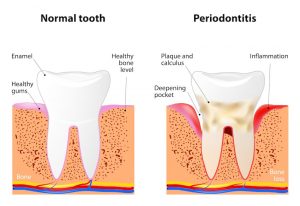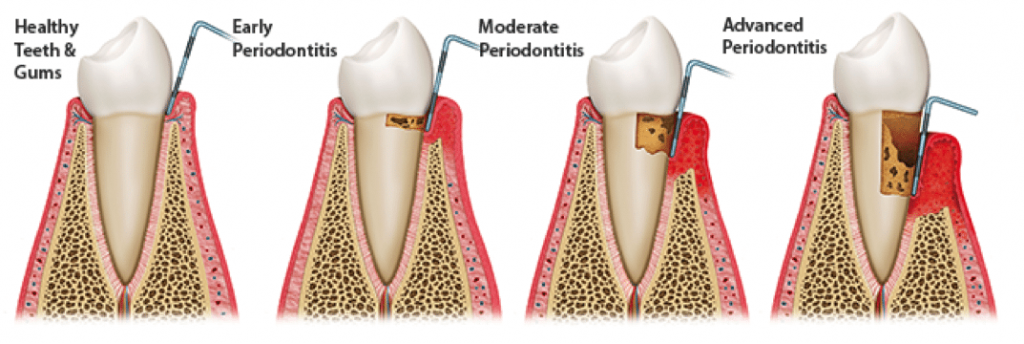Periodontal Disease Shows No Pain: It’s Symptoms Are Extremely Subtle
 Commonly known as gum disease, periodontal disease is caused by plaque building up on your teeth and gums. Plaque is that furry layer of bacteria you feel on your teeth if you haven’t brushed for a few days. This layer then calcifies and hardens causing gum tissue to become infected. If this goes untreated it leads to tooth loss, and your gums and bone holding your teeth recede in the presence of this scale.
Commonly known as gum disease, periodontal disease is caused by plaque building up on your teeth and gums. Plaque is that furry layer of bacteria you feel on your teeth if you haven’t brushed for a few days. This layer then calcifies and hardens causing gum tissue to become infected. If this goes untreated it leads to tooth loss, and your gums and bone holding your teeth recede in the presence of this scale.
The periodontium is not just gums; it encompasses all the tissue around the teeth, including the jawbone and ligaments. So, periodontal disease can affect all these areas, particularly in advanced cases.
Gingivitis and periodontitis are the two main types of periodontal disease:
- Gingivitis is simply the inflammation of your gums, which can be identified easily through symptoms such as bleeding gums. Gingivitis is an easy fix and the damage it causes is reversible.
- Periodontitis is far more serious than gingivitis. As well as affecting the gums, it also attacks the soft tissue and bone that your teeth are nestled in. The bone loss it can cause isn’t reversible and can ultimately lead to extensive surgery and tooth loss if not treated at the earliest possible time.
What is a Pocket?

Treating Periodontal Disease Step-by-Step
Step 1 – Get in Early
The best treatment for periodontal disease is early treatment. It is only when this dental hygiene issue is ignored and allowed to progress that it can be the cause of extensive time consuming treatments. So, if your teeth and gums feel sore and tender, or experience bleeding in the gums, be aware that ignoring it will hurt your mouth and hip-pocket more than it needs to.
Step 2 – Scaling and Cleaning
Working together with Care Dental Camberwell will help in treatment and prevention enormously. You should always follow up regular scale and clean sessions with diligent home oral hygiene. This can be all you need to treat some minor gum diseases, such as gingivitis and we will help you develop the needed home hygiene skills.
Step 3 – Scaling and Root Planing
If you have periodontitis, the first step will usually involve a deep-penetrating type of cleaning named ‘scaling and root planing’. The cleaning takes away all the plaque and tartar around the tooth, gums and root surfaces. It helps to shrink periodontal pockets and to heal your gum tissue.
Step 4 – Medications
Our therapists might want to compliment the cleaning with some medication, which can range from a mouth rinse, specific tooth pastes, gells and in some cases antibiotics.
Step 5 – Follow Up
You will need to visit your dentist to see how your cleaning, hygiene and disease are tracking. Hopefully, your visit will simply require a quick check-up, but if the periodontal pockets are still deep and bone has been affected, then you may need to undergo surgery to prevent losing your teeth.
The more uneventful this step is, the better the outcome, but ignoring any part of the process that your dentist requires can have some significant degenerative consequences.
Step 6 – Surgery
If cleaning and maintenance aren’t getting the job done then surgery could be the best option to remove inflamed tissues and contain/reduce bone damage around the teeth.
During surgery, we’ll be able to reach the places a more superficial cleaning couldn’t. The surgery aims to get rid of stubborn tartar build up under the gums and along the roots to remove the damage that’s been caused by the progression of the disease.
Step 7 – Further Procedures if Necessary
If you have bone that has been weakened or damaged by periodontal disease then it is possible that you will require bone surgery and/or bone grafts. Tissue-stimulating proteins can also be used to give your body the encouragement and help it needs to self-heal damaged bone and tissue.
If a large amount of gum tissue has been lost, a soft-tissue gum graft can be performed to help stop gum recession. This procedure takes some gum tissue from your palate, which is used to cover up an exposed root and reduce sensitivity.
Step 8 – Appliances
If you have some loose teeth hanging in there that need a little help, a splint, bite or mouth guard can be very effective in holding things in place while your mouth heals.
Step 9 – Follow Up
Unless you want to waste all that work, seeing our therapist on a regular basis following your periodontal treatment is an absolute necessity. Keeping your mouth clean every day is a vital contribution to warding off periodontal disease but you still require the expert opinion of a clinician to make sure things don’t get out of hand again.
Step 10 – Do’s and Don’t
By brushing twice a day, eating a balanced diet, staying aware and reactive to any soreness or bleeding and scheduling regular dental visits you are far less likely to suffer any serious consequences from periodontal disease. Avoiding tobacco is also key.
Through this step-by-step analysis of treating periodontal disease it is clear how bad things can get if you don’t take good general care of your oral hygiene. A failure to react urgently to any discomfort or gum disease can be a slippery slope to big problems that could have easily have been nipped in the bud! If you’re concerned about the state of your teeth or gums, make an appointment with us today.
